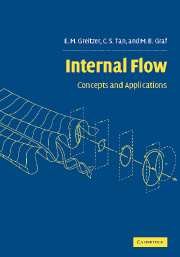Book contents
- Frontmatter
- Contents
- Preface
- Acknowledgements
- Conventions and nomenclature
- 1 Equations of motion
- 2 Some useful basic ideas
- 3 Vorticity and circulation
- 4 Boundary layers and free shear layers
- 5 Loss sources and loss accounting
- 6 Unsteady flow
- 7 Flow in rotating passages
- 8 Swirling flow
- 9 Generation of streamwise vorticity and three-dimensional flow
- 10 Compressible internal flow
- 11 Flow with heat addition
- 12 Non-uniform flow in fluid components
- References
- Supplementary references appearing in figures
- Index
6 - Unsteady flow
Published online by Cambridge University Press: 14 January 2010
- Frontmatter
- Contents
- Preface
- Acknowledgements
- Conventions and nomenclature
- 1 Equations of motion
- 2 Some useful basic ideas
- 3 Vorticity and circulation
- 4 Boundary layers and free shear layers
- 5 Loss sources and loss accounting
- 6 Unsteady flow
- 7 Flow in rotating passages
- 8 Swirling flow
- 9 Generation of streamwise vorticity and three-dimensional flow
- 10 Compressible internal flow
- 11 Flow with heat addition
- 12 Non-uniform flow in fluid components
- References
- Supplementary references appearing in figures
- Index
Summary
Introduction
Unsteady flow phenomena are important in fluid systems for several reasons. First is the capability for changes in the stagnation pressure and temperature of a fluid particle; the primary work interaction in a turbomachine is due to the presence of unsteady pressure fluctuations associated with the moving blades. A second reason for interest is associated with wave-like or oscillatory behavior, which enables a greatly increased influence of upstream interaction and component coupling through propagation of disturbances. The amplitude of these oscillations, which is set by the unsteady response of the fluid system to imposed disturbances, can be a limiting factor in defining operational regimes for many devices. A final reason is the potential for fluid instability, or self-excited oscillatory motion, either on a local (component) or global (fluid system) scale. Investigation of the conditions for which instability can occur is inherently an unsteady flow problem.
Unsteady flows have features quite different than those encountered in steady fluid motions. To address them Chapter 6 develops concepts and tools for unsteady flow problems.
The inherent unsteadiness of fluid machinery
To introduce the role unsteadiness plays in fluid machinery, consider flow through an adiabatic, frictionless turbomachine, as shown in Figure 6.1 (Dean, 1959). At the inlet and outlet of the device, and at the location where the work is transferred (by means of a shaft, say), conditions are such that the flow can be regarded as steady. We also restrict discussion to situations in which the average state of the fluid within the control volume is not changing with time.
Information
- Type
- Chapter
- Information
- Internal FlowConcepts and Applications, pp. 279 - 346Publisher: Cambridge University PressPrint publication year: 2004
Accessibility standard: Unknown
Why this information is here
This section outlines the accessibility features of this content - including support for screen readers, full keyboard navigation and high-contrast display options. This may not be relevant for you.Accessibility Information
- 1
- Cited by
